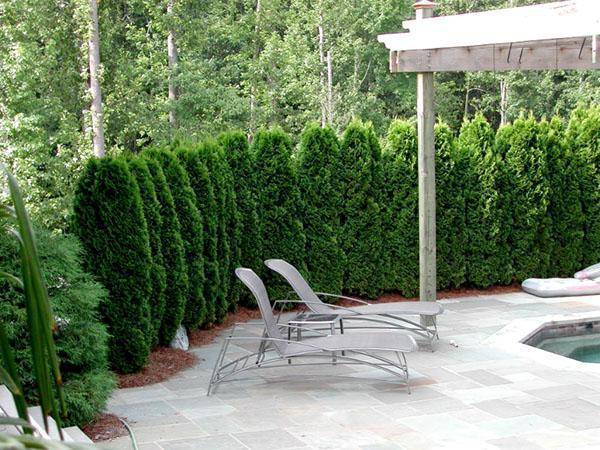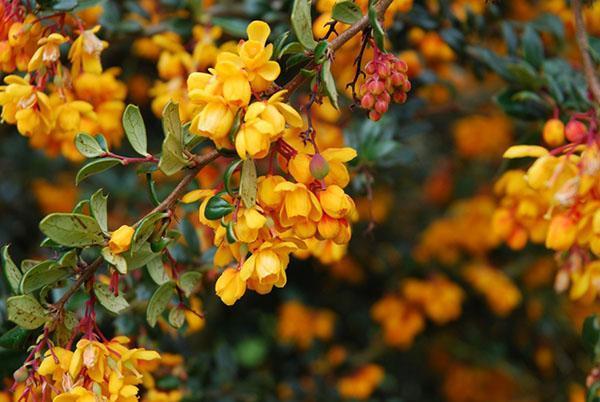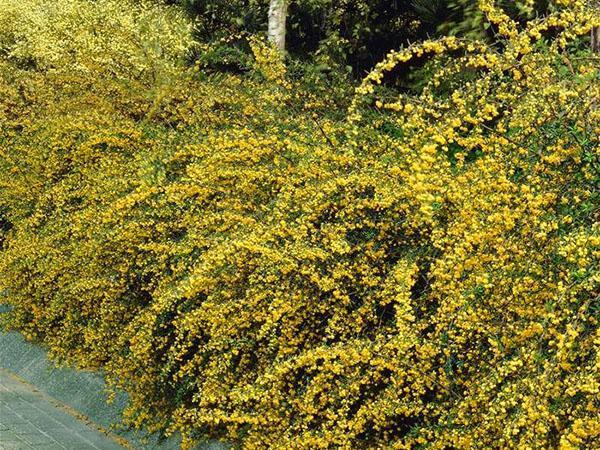Lianas and shrubs for live, fast-growing, perennial and evergreen hedges
 Most owners of private houses and cottages are trying to diversify their personal plot and facade of their buildings. A fast-growing, perennial, evergreen hedge will serve as an excellent alternative to dull brick fences and metal structures. It is not difficult to grow a live fence on your site. It is enough to choose a plant that tolerates climatic conditions well and take proper care of it.
Most owners of private houses and cottages are trying to diversify their personal plot and facade of their buildings. A fast-growing, perennial, evergreen hedge will serve as an excellent alternative to dull brick fences and metal structures. It is not difficult to grow a live fence on your site. It is enough to choose a plant that tolerates climatic conditions well and take proper care of it.
Growing a wall from a dense flowering plant in one season will not work. It will take several seasons. Consider options for evergreen climbing plants for hedges and shrubs.
Barberry Darwin

In order for the shrub to take the correct shape during growth in the form of a hedge, the shoots are planted at a distance of 25 centimeters from each other or in a chess pattern. A year after planting, the young branches of the bush are cut on the sides. The remaining main branches continue to grow upward. An adult shrub grows above 1.5 meters. On the shrubs, bright orange flowers are formed, which are replaced by blue fruits.
Narrow-leaved barberry
 The plant belongs to evergreen shrubs for hedges. Adult barberry reaches a height of 2.5 meters. As it grows, its branches are directed high up. The older the plant becomes, the lower they fall. If the branches are not cut, they can grow up to 3 m long and bend to the ground. The shoots of the plant are naked, dark red in color.
The plant belongs to evergreen shrubs for hedges. Adult barberry reaches a height of 2.5 meters. As it grows, its branches are directed high up. The older the plant becomes, the lower they fall. If the branches are not cut, they can grow up to 3 m long and bend to the ground. The shoots of the plant are naked, dark red in color.
The leaves are small, oval with a pointed end, reaching 2 centimeters in length. The narrow-leaved barberry blooms in late spring. The plant has bright yellow flowers, collected in neat bouquets. During flowering, a pleasant aroma comes from the shrub. By the beginning of autumn, the flowers are replaced by blue berries. They have a spherical shape and a diameter of no more than one centimeter.
Horizontal cotoneaster
 The shrub grows quickly in the garden and does not require much maintenance. Gardeners choose this particular plant due to the large number of leaves and minor flowers. The cotoneaster can be planted in open sunny areas and in the shade. Mature shrubs reach 50 centimeters in height. The shrub tolerates any climatic conditions well. It grows at low temperatures, the root does not die without shelter for the winter.
The shrub grows quickly in the garden and does not require much maintenance. Gardeners choose this particular plant due to the large number of leaves and minor flowers. The cotoneaster can be planted in open sunny areas and in the shade. Mature shrubs reach 50 centimeters in height. The shrub tolerates any climatic conditions well. It grows at low temperatures, the root does not die without shelter for the winter.
The shrub has round leaves pointing in one direction. In the warm season, they are bright green. With the onset of cold weather, the leaves turn red. The horizontal cotoneaster blooms with small red flowers, which are replaced by red berries at the beginning of autumn.
In the first year of planting cotoneaster will gain strength. During planting, the cuttings are planted at a distance of half a meter. In the process of growth, the shrub forms a dense, low living wall, requiring annual cutting.Young branches are trimmed in early spring, before bud formation.
The shrub does not require frequent watering. Even in dry summers, the cotoneaster is watered no more than three times a month. If the plant begins to wither for unknown reasons, then you can add fertilizer to the soil and loosen it at the roots of the bush.
Thuja
There are several types of fast-growing, perennial, evergreen thuja for hedges.
Thuja Brabant
 The shrub has a vertical crown. An adult plant reaches a height of five meters. The shrub grows rather quickly. With little care, the plant grows 40 centimeters high and 20 centimeters wide every year. It is planted as a hedge at a distance of half a meter from each other. If you fertilize the soil and regularly water the plant, then after a few years from thuja a dense, green wall is formed. The shrub is pruned in early spring and late summer in preparation for winter.
The shrub has a vertical crown. An adult plant reaches a height of five meters. The shrub grows rather quickly. With little care, the plant grows 40 centimeters high and 20 centimeters wide every year. It is planted as a hedge at a distance of half a meter from each other. If you fertilize the soil and regularly water the plant, then after a few years from thuja a dense, green wall is formed. The shrub is pruned in early spring and late summer in preparation for winter.
Thuja Smaragd
 The genus of evergreen shrubs for hedges was brought from the Caucasus. Refers to tall varieties. The shape of the crown is conical. It tolerates low air temperatures well. Differs in bright green color of the crown in the cold season. It grows very slowly, so it does not require frequent cutting of branches.
The genus of evergreen shrubs for hedges was brought from the Caucasus. Refers to tall varieties. The shape of the crown is conical. It tolerates low air temperatures well. Differs in bright green color of the crown in the cold season. It grows very slowly, so it does not require frequent cutting of branches.
In order for the shrub to please with a green crown, it must be thoroughly watered. The plant does not tolerate drought well and dries quickly.
Tuya Holmstrup
 Gardeners believe that this plant is intended for especially lazy landowners. Having planted thuja Holmstrup as a live, fast-growing, perennial, evergreen hedge, you don't have to worry about its leaving. It is required to trim the plant no more than once every two years. Thuja grows 5 centimeters wide and 11 centimeters high annually. The coniferous crown differs from other varieties in its curliness. In winter, the plant remains bright green.
Gardeners believe that this plant is intended for especially lazy landowners. Having planted thuja Holmstrup as a live, fast-growing, perennial, evergreen hedge, you don't have to worry about its leaving. It is required to trim the plant no more than once every two years. Thuja grows 5 centimeters wide and 11 centimeters high annually. The coniferous crown differs from other varieties in its curliness. In winter, the plant remains bright green.
Ivy
There are several types of evergreen vines for hedges.
Ivy
 The plant belongs to a climbing evergreen hedge. Ivy the common one tolerates winter and low temperature conditions well, while not shedding leaves. Liana braids metal fences, nets and trees with its branches. When protected by a building from the wind, it survives in extreme cold. If you remove it from the fence and use common ivy as a ground cover plant, then in order to survive the winter, it will need a layer of snow of at least 15 centimeters.
The plant belongs to a climbing evergreen hedge. Ivy the common one tolerates winter and low temperature conditions well, while not shedding leaves. Liana braids metal fences, nets and trees with its branches. When protected by a building from the wind, it survives in extreme cold. If you remove it from the fence and use common ivy as a ground cover plant, then in order to survive the winter, it will need a layer of snow of at least 15 centimeters.
In order to grow a liana, it is enough to loosen the soil in which it germinates. Common ivy grows for a long time. It has multiple leaves, similar to maple leaves, but smaller. The color of the branches is dark green. Leaves are brighter in color with numerous dark and light veins, depending on the age of the plant and the season.
Ivy colchis
 Liana has thin shoots. When landing near a fence, trellis or near trees, it can climb up to a height of 28 meters. The leaves of Colchis ivy are large. They reach 22 centimeters in length and 15 centimeters in width. The inside of the leaves is dark green, with a light milky border around the edges. The inflorescences of the plant are covered with hairs.
Liana has thin shoots. When landing near a fence, trellis or near trees, it can climb up to a height of 28 meters. The leaves of Colchis ivy are large. They reach 22 centimeters in length and 15 centimeters in width. The inside of the leaves is dark green, with a light milky border around the edges. The inflorescences of the plant are covered with hairs.
Ivy blooms with oblong flowers, small in size. The stamens are larger than the petals themselves. Flowers are replaced by fruits, up to 1.5 centimeters in diameter, which contain up to 6 seeds. Colchis ivy grows well in the shade, loves moisture. Tolerates low temperatures.